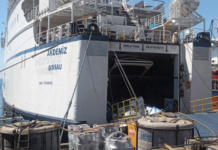
ANALYSIS: By Professor Eelco Rohling in Canberra
Getting climate change under control is a formidable, multifaceted challenge. Analysis by my colleagues and me suggests that staying within safe warming levels now requires removing carbon dioxide from the atmosphere, as well as reducing greenhouse gas emissions.
The technology to do this is in its infancy and will take years, even decades, to develop, but our analysis suggests that this must be a priority. If pushed, operational large-scale systems should be available by 2050.
We created a simple climate model and looked at the implications of different levels of carbon in the ocean and the atmosphere. This lets us make projections about greenhouse warming, and see what we need to do to limit global warming to within 1.5℃ of pre-industrial temperatures – one of the ambitions of the 2015 Paris climate agreement.
To put the problem in perspective, here are some of the key numbers.
Humans have emitted 1,540 billion tonnes of carbon dioxide gas since the industrial revolution. To put it another way, that’s equivalent to burning enough coal to form a square tower 22 metres wide that reaches from Earth to the Moon.
Half of these emissions have remained in the atmosphere, causing a rise of CO₂ levels that is at least 10 times faster than any known natural increase during Earth’s long history. Most of the other half has dissolved into the ocean, causing acidification with its own detrimental impacts.
Although nature does remove CO₂, for example through growth and burial of plants and algae, we emit it at least 100 times faster than it’s eliminated. We can’t rely on natural mechanisms to handle this problem: people will need to help as well.
What’s the goal?
The Paris climate agreement aims to limit global warming to well below 2℃, and ideally no higher than 1.5℃. (Others say that 1℃ is what we should be really aiming for, although the world is already reaching and breaching this milestone.)
In our research, we considered 1℃ a better safe warming limit because any more would take us into the territory of the Eemian period, 125,000 years ago. For natural reasons, during this era the Earth warmed by a little more than 1℃.
Looking back, we can see the catastrophic consequences of global temperatures staying this high over an extended period.
Sea levels during the Eemian period were up to 10m higher than present levels. Today, the zone within 10m of sea level is home to 10 percent of the world’s population, and even a 2m sea-level rise today would displace almost 200 million people.
Clearly, pushing towards an Eemian-like climate is not safe. In fact, with 2016 having been 1.2℃ warmer than the pre-industrial average, and extra warming locked in thanks to heat storage in the oceans, we may already have crossed the 1℃ average threshold.
To keep warming below the 1.5℃ goal of the Paris agreement, it’s vital that we remove CO₂ from the atmosphere as well as limiting the amount we put in.
So how much CO₂ do we need to remove to prevent global disaster?
Are you a pessimist or an optimist?
Two rough scenarios
Currently, humanity’s net emissions amount to roughly 37 gigatonnes of CO₂ per year, which represents 10 gigatonnes of carbon burned (a gigatonne is a billion tonnes). We need to reduce this drastically. But even with strong emissions reductions, enough carbon will remain in the atmosphere to cause unsafe warming.
Using these facts, we identified two rough scenarios for the future.
The first scenario is pessimistic. It has CO₂ emissions remaining stable after 2020. To keep warming within safe limits, we then need to remove almost 700 gigatonnes of carbon from the atmosphere and ocean, which freely exchange CO₂. To start, reforestation and improved land use can lock up to 100 gigatonnes away into trees and soils. This leaves a further 600 gigatonnes to be extracted via technological means by 2100.
Technological extraction currently costs at least US$150 per tonne. At this price, over the rest of the century, the cost would add up to US$90 trillion. This is similar in scale to current global military spending, which – if it holds steady at around US$1.6 trillion a year – will add up to roughly US$132 trillion over the same period.
The second scenario is optimistic. It assumes that we reduce emissions by 6 percent each year starting in 2020. We then still need to remove about 150 gigatonnes of carbon.
As before, reforestation and improved land use can account for 100 gigatonnes, leaving 50 gigatonnes to be technologically extracted by 2100. The cost for that would be US$7.5 trillion by 2100 – only 6 percent of the global military spend.
Of course, these numbers are a rough guide. But they do illustrate the crossroads at which we find ourselves.
The job to be done
Right now is the time to choose: without action, we’ll be locked into the pessimistic scenario within a decade. Nothing can justify burdening future generations with this enormous cost.
For success in either scenario, we need to do more than develop new technology. We also need new international legal, policy, and ethical frameworks to deal with its widespread use, including the inevitable environmental impacts.
Releasing large amounts of iron or mineral dust into the oceans could remove CO₂ by changing environmental chemistry and ecology. But doing so requires revision of international legal structures that currently forbid such activities.
Similarly, certain minerals can help remove CO₂ by increasing the weathering of rocks and enriching soils. But large-scale mining for such minerals will impact on landscapes and communities, which also requires legal and regulatory revisions.
And finally, direct CO₂ capture from the air relies on industrial-scale installations, with their own environmental and social repercussions.
Without new legal, policy, and ethical frameworks, no significant advances will be possible, no matter how great the technological developments. Progressive nations may forge ahead toward delivering the combined package.
The costs of this are high. But countries that take the lead stand to gain technology, jobs, energy independence, better health, and international gravitas.
Dr Eelco Rohling is Professor of Ocean and Climate Change at the Australian National University. Disclosure statement: He receives funding from the Australian Research Council and the UK Natural Environment Research Council. He is also affiliated with the University of Southampton, UK. This article was first published by The Conversation and is republished by Asia Pacific Report under a Creative Commons licence.













































